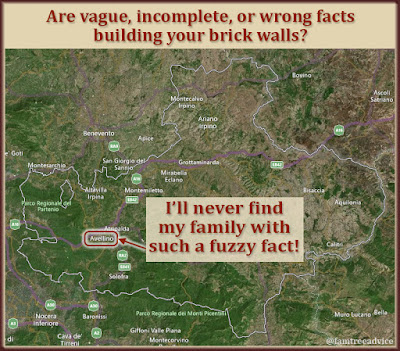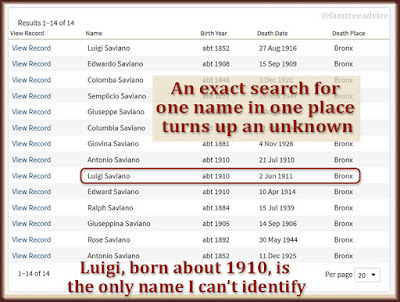Myths, mistakes, and fuzzy facts can hold back your family tree research.
Is your brick wall based on one completely wrong "fact"? What if you only hit that wall because you started with a family history mistake?
Here are 3 types of mistakes that can hamper your research.
Unrelated Celebrities
My ex-in-laws said their great uncle was Edward Smith, captain of the Titanic. That led to lots of genealogy problems. I was trying to place my ex's great grandfather (Walter Smith) in the same location as the ill-fated captain. They were brothers, after all.
Then I made a surprising discovery. Captain Smith never had a brother!
Without this myth muddying up the waters, I was able to find out where Walter Smith came from. And it had nothing to do with the captain.
 |
| You may think you have a reliable source. But some memories are not facts. |
Mistaken Identity
Decades ago, my brother was writing a college paper about our family history. Grandpa told him our great grandmother's (Grandpa's mother-in-law's) last name was Ferrara. There was no reason to doubt Grandpa, and no one else to ask.
But Grandpa was mistaken. In 2003 my aunt told me the last name was Caruso. If not for that, I'd never have gotten anywhere on that branch of my family tree.
I put my family tree on Ancestry.com with my great grandmother listed as Maria Rosa Caruso. That attracted the attention of a relative I didn't know. She was working on her husband's family tree. She found my tree and realized her husband and I were 2nd cousins. We share a set of great grandparents: Pasquale Iamarino and Maria Rosa Caruso.
This cousin-in-law gave me the clue I needed to research a common name like Caruso. She said Maria Rosa Caruso was from Pescolamazza, Italy. When that town wasn't on the map, I discovered that it changed its name to Pesco Sannita. At last I could build that part of my family tree.
 |
| Once I had her true maiden name and hometown, the brick wall disappeared. |
Not Quite the Right Place
In 2004, my great aunt Stella repeated something I'd heard ever since I was a child. Our family came from 2 places in Italy: Pastene and Avellino.
Over time I found that Pastene is a small hamlet in a larger town called Sant'Angelo a Cupolo. When my great aunt Stella's parents came to America in 1899, they came from Sant'Angelo a Cupolo.
OK, so the family was from Pastene. But what about Avellino? That was a problem for 2 reasons:
- If both of Aunt Stella's parents were from Pastene, who was from Avellino?
- Avellino is both a city and a much larger province. Where in Avellino were my people from?
I kept Avellino in the back of my mind until I found the World War II draft registration card for my 2nd great uncle. He went by "Sam" in America, but his name was Semplicio Saviano. My great uncle Sam was the older brother of my great grandmother.
Sam's World War I draft registration card didn't even say what country he was born in. But his World War II card, recorded when he was a 65-year-old man, showed his town of birth.
It's misspelled as Tofo, Avillino. In reality, he was born in Tufo, a small town in the province of Avellino.
Finally a piece of evidence to support this bit of passed-down history. I later found Uncle Sam's 1877 birth record from Tufo, and that of an older brother my family didn't know about. (He died as a child.)
Then I found what may be the reason the family said they were from Avellino, not Tufo. My 2nd great grandmother (Uncle Sam's mother) was from another town in Avellino. She was born in, and married my 2nd great grandfather in Santa Paolina, Avellino.
 |
| Without the right location, it can be nearly impossible to find some ancestors. |
It all came full circle when I read the 1871 marriage papers for my 2nd great grandparents.
My 2nd great grandmother Vittoria was born in Santa Paolina. Her husband Antonio was born in Pastene. I still find all this unusual:
- Antonio was born in Pastene, Benevento.
- He married Vittoria in Santa Paolina, Avellino, in 1871. It's a 30-minute drive today from Pastene to Santa Paolina. Imagine doing it on a horse, or in a mule-drawn cart. How did that happen?
- Antonio and Vittoria had a baby girl in Santa Paolina in 1872 who died right away. The they moved about 15 minutes away (by modern transportation) to Tufo. Two of Vittoria's brothers lived there.
- They had 2 more children in Tufo in 1875 and 1877.
- Then they moved to Pastene! There they had 4 more children from 1879–1887.
- In 1898, they took all but one of their surviving children to settle in New York City once and for all.
My great grandparents followed the next year.
It was a long, strange trip for my 2nd great grandfather. From Pastene to Santa Paolina to Tufo to Pastene to the Bronx. It was all a brick wall until I found Uncle Sam's draft card.
Here's what I want you to do. Look at one of your brick walls. Are your facts based on less-than-solid evidence? If one of your assumptions is wrong, does everything else fall apart?
Make sure the foundation of that brick wall is solid. You may find a mistaken, misunderstood, or missing fact underneath it all. If you pull that mistake out, will your brick wall come crumbling down?



